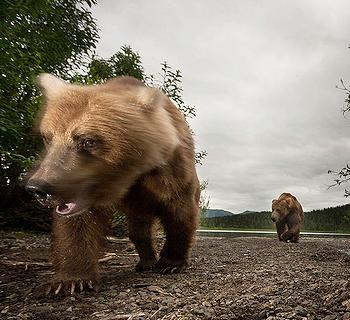Alaska Hears Objections to Bear Baiting, Snaring, Spotlighting
ANCHORAGE, Alaska, January 16, 2012 (ENS) – Objecting to hunting methods currently authorized by the state of Alaska, the National Parks Conservation Association Friday testified on behalf of seven proposed regulation changes to the Alaska Board of Game.
The need for regulations against bear baiting, snaring, spotlighting and shooting bear cubs in national preserves, among other issues, were raised at the hearing. Backed by letters from nearly 1,700 NPCA supporters in Alaska and throughout the northwestern United States, the group presented its strongest case.
“In its desire to increase the numbers of moose and caribou for sportsman to hunt, the state has declared a quiet war on Alaska’s bears including those living in Alaska’s national preserves,” said NPCA Alaska Regional Director Jim Stratton. “It is time to put an end to this madness and ensure these animals are protected for the enjoyment of our kids and grandkids.”
In an effort to increase moose populations, the Board of Game began wolf reduction efforts in 2004, which resulted in higher winter survival of moose calves. In 2007, the board eased bear regulations to reduce bear numbers in order to increase spring and summer moose calf survival.
 |
Grizzly bears on the beach at the Bristol Bay village of Aleknagik (Photo by Jonny Armstrong) |
At Friday’s hearing the Board of Game took testimony on its regulations covering the take of furbearers and fur animals with firearms and the taking of black bears with traps or snares and artificial light.
The board is also considering its rules on permits for taking black bears with the use of bait or scent lures, including the number of bait sites maintained by guides and assistant guides; baiting permit dates; prohibiting baiting on National Park Service lands; using scent while floating; requirements for accompanying hunters at bait sites; same-day-airborne taking of black bear and bait site identification.
“It is very much an adaptive experiment,” said regional supervisor Bruce Dale of the policy allowing baiting and use of foot snares in an area 40 miles southwest of Anchorage near the villages of Tyonek and Beluga. In March 2011, when the new policy went into effect, he said, “The effectiveness of reducing both bear species through harvest methods to increase moose calf survival has not been demonstrated.”
Stratton particularly objects to “spotlighting,” a method of killing bears that is currently allowed by the Board of Game.
“Imagine crawling into a bear den to shoot a hibernating Yogi or Smokey taking his winter’s nap. It’s legal in Alaska,” said Stratton. “And with the availability of heat-seeking devices, it’s far too easy to find bear dens.”
The board also currently authorizes killing cubs and sows with cubs and the selling of bear parts. Snaring is another method currently allowed in national preserves and statewide, that is objectionable to the National Parks Conservation Association, Stratton said.
Addressing the snaring issue at the Board meeting, former Alaska Governor Tony Knowles said that the policy of bear snaring is not hunting but a killing method that indiscriminately kills both black and grizzly bears, including females with cubs, older cubs, and females.
Knowles testified that he “joins the unprecedented number of Alaskan scientists and wildlife managers with over 1,000 years of combined bear management experience who have stated that bear snaring is unscientific, unethical, and incompatible with the principles of modern wildlife management.”
The National Park Service regularly identifies state hunting regulations that conflict with how it manages wildlife, and submits requests for the Board of Game to either change the rules or exempt NPS lands.
Since 2000, NPCA has documented more than 50 times where the state has rejected reasonable requests and adopted hunting regulations that conflict with the NPS wildlife management mandate, which provides for natural and healthy wildlife populations on Park Service lands.
Alaska contains about 98 percent of the U.S. brown bear population and 70 percent of the total North American population. Brown bears are found throughout the state and are the top predator in Alaska.
Most brown bears in Alaska are grizzly bears, the subspecies of brown bear found throughout North America. In Alaska, there are thought to be over 30,000 grizzly bears. In addition, Kodiak Island is inhabited by Kodiak bears, another subspecies that is the largest type of brown bear in the world.
The smaller black bear is also found throughout the state, with an estimated population of 100,000. Black bears are considered a nuisance because they can stroll through towns, camps, backyards, and streets attracted to easy food sources such as garbage.
Copyright Environment News Service (ENS) 2012. All rights reserved.
© 2012, Environment News Service. All rights reserved. Content may be quoted only with proper attribution and a direct link to the original article. Full reproduction is prohibited.
